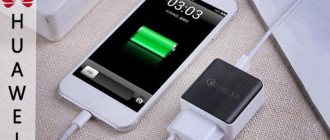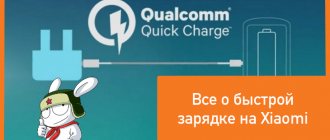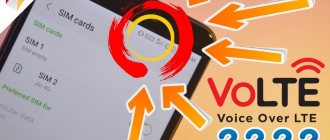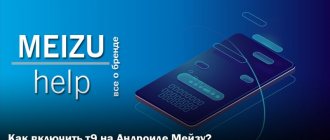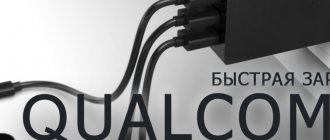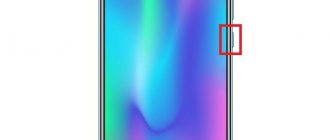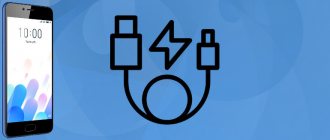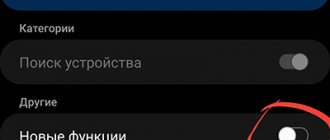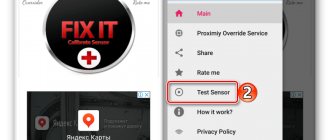Which smartphones support fast charging?
There is no single standard, so many smartphone manufacturers have developed their own rules. Let's figure out what standards exist and which phones support them.
Quick Charge
Quick Charge technology developed by Qualcomm is the most successful. There are four versions of this standard. New memory devices of the latest versions - 4.0/4.0+ develop output power up to 27 W. Thanks to this, they can charge the battery in 15 minutes from 0 to 50%.
It is impossible to list smartphone models that support this standard, since there are many of them. Therefore, to find out whether a phone supports this technology, you need to understand each specific model. When determining compatibility, it is useful to know that Quick Charge can only work with gadgets equipped with Qualcomm processors. Gadgets that support this format are backwards compatible.
Here is a list of smartphones that support the latest Quick Charge 4+ standard:
- Black Shark 2;
- BQ Aquaris X2? X2 Pro;
- Nubia mini, Z17 and Z18;
- Razer Phone;
- Redmi K20, K20 Pro;
- Samsung Galaxy A70 and A80;
- Xiaomi Mi 8, Mi9, A2, MIX3, Poco F1;
- ZTE AXON Pro 9 and 10.
Apple
Apple has also developed its own technology. Gadgets that support it can receive up to 29 W of power from the charger. Thanks to this, the iPhone is charged from 0 to 50% in 30 minutes.
The following gadget models support the Apple standard:
- iPhone 8 and later models;
- the first generation of iPad Pro with a screen of 11 and 12.9 inches, as well as new versions of these gadgets;
- third generation iPad Air;
- fifth generation iPad mini.
Samsung Adaptive Fast Charging
The power that Adaptive Fast Charging can show is 18 watts. This is enough to charge the Galaxy Note 5 smartphone, equipped with a 3000 mAh battery, up to 50%. It will take two hours to completely fill the same battery. You can use a Qualcomm Quick Charge 2.0 adapter, but in this case the replenishment of energy will be slower.
This technology is supported by all Samsung S series smartphones, starting with the Galaxy S6, as well as Note devices, starting with the Galaxy Note 4.
Motorola TurboPower (Lenovo)
The Motorola TurboPower standard is based on Quick Charge 2.0 technology. The difference between TurboPower is the increased power of 28.5 W. It is supported by smartphones Moto X Pure Edition, Droid Turbo 2 and later versions of gadgets produced under the Motorola brand.
Media Tek Pump Express
Pump Express technology was developed by Media Tek and is considered the closest rival to the previous one. The latest version of Media Tek Pump Express 4.0 differs from competitors in that the battery is replenished with energy directly and does not involve the controller. Operating modes and battery temperature are controlled by the memory.
For a smartphone to support Pump Express, it must be equipped with a USB Type-C port. Information about gadget compatibility with this standard must be checked for each specific model. Compatible models should be found among phones using the Media Tek chipset.
VOOC Flash Charging
The power that VOOC Flash Charging can provide is 25 W. This is enough to replenish a 3000 mAh battery up to 75% in 30 minutes. The following smartphones support this technology:
- OPPO A1, A3, A7x, A73s, A83, A9, A91;
- OPPO F7, F9, F11;
- OPPO R15, R17;
- OPPO Reno A, Z, 10xZoom, 5G;
- OPPO Reno 2, Reno 2F, Reno 2Z;
- OnePlus 3, 5, 6, 7;
- Realme 3 Pro, 5 Pro, Q, X2, X50 5G;
Huawei SuperCharge
Huawei SuperCharge technology can provide power up to 25W.
This will be enough to charge a 4000 mAh battery in thirty minutes to 57%. The following phones are capable of working with this technology:
- Huawei nova 2, 2s, 2 plus, 3, 4, 4e, 5i Pro, 5z, P9, P9 Plus, P10 Lite, P10 Plus, P20 lite, P20 lite (2019), P30 lite, Mate 8, Mate 9, 9 Pro, 9 Porsche Design, Mate 10, 10 Pro, 10 Porsche Design, Mate 20, 20 X, Mate RS Porsche Design, Mate 20 lite;
- P10 Plus, P20 lite, P20 lite (2019), P30 lite, Mate 8, Mate 9, 9 Pr, 20S, Holly 2 Plus, Play, HONOR Note 10, HONOR View, HONOR View 10, HONOR View 20;
Fast charging technology: what is it?
For quite a long time, mobile phones did not need accelerated charging. Why, if the device was connected to the charger only once every three to four days? But with the advent of smartphones, everything changed. These devices have increased energy consumption. As a result, we have become accustomed to the fact that in most cases they need to be charged every night. But what if you forgot to connect your gadget to the charger in the evening, and you have to go to work in the morning? It is in such situations that fast charging comes to the rescue. While you brush your teeth, make your bed and get ready for work, the battery will be recharged by 50% or even more. Let's talk about this technology in a little more detail.
Traditional charging
Any battery operates on the principle of an electromechanical process. It runs in both directions - the battery can receive energy, storing it, or release it. Over the years, engineers have tried different chemical current sources. Previously, nickel and lead were used, but now all cell phone batteries are based on lithium. They can be lithium-ion or lithium-polymer - it doesn't matter at all, since fast charging technology works with both types of batteries. The main advantage of lithium is that it does not have a “memory effect”. As a result, you don’t have to wait for the moment when your smartphone is completely discharged. Yes, and you don’t have to charge it to 100%. If not for this fact, fast charging would be useless. As for the disadvantages of lithium batteries, they include a gradual loss of capacity and a fire hazard.
More on the topic: How to change the time on Android?
Modern smartphones contain batteries with a capacity of 2000 to 7000 mAh. The nominal battery voltage is most often 3.5-3.7 V. When the battery is fully charged, the voltage can be increased to 4.2 V, which allows increasing the performance of the processor and some other components. As for charging the battery itself, it used to be very simple - current was supplied with a strictly defined power until the charge level reached approximately 90%. Then the power was gradually reduced so as not to “overcharge” the battery; this was done by a special controller. And so on until reaching 100 percent charge. As a result, the charging time was 2-2.5 hours, depending on the battery capacity.
How does fast charging work?
Qualcomm was the first to try to change something. In 2012, it introduced the first version of Quick Charge technology. According to the idea of the manufacturer of mobile chipsets, at the first stage the charger should produce a current of the maximum possible power. And when the battery controller realized that the charge level had reached a certain level, the power was reduced.
How does fast charging differ from regular charging? Let's look at this with an example. Let's take the most common phone charger (pictured above). On its body we will see the inscription: “Output 5V/1A”. This means that the device outputs a maximum current of 5 volts and 1 ampere. The output power of such a charge is approximately 5 watts. Quick Charge 1.0 technology has changed little. Smartphones that support it have learned to accept electricity with a current of 2 A. All other parameters of the charger remain the same. Given the same battery capacity, full charging is carried out 30% faster.
The second version of the technology from Qualcomm turned out to be much more interesting. It consists in an even closer interaction between the battery controller and the charger. From now on, the current could reach 3 A. Also now, as charging progressed, the voltage changed - at first it was 12 V, then decreased to 9 V, and finally dropped to the standard 5 V. Compared to using a traditional charger, the process was accelerated by 60 %! The disadvantage of this technology is the high cost of the charger, because it has a special chip built into it. However, most consumers do not care about this, because most often the charger is included with the smartphone, and the need to buy a new one arises extremely rarely.
In September 2021, Qualcomm introduced Quick Charge 3.0 technology. The chargers and battery controllers that have it are even smarter. Now the optimal voltage is selected individually for a specific device and battery charge level. The voltage now varies from 3.6 to 20 V. The change step is only 200 mV. As a result, the third version of the technology turned out to be 38% more efficient than the second. Snapdragon 430, 617, 618, 620 and 820 processors received Quick Charge support.
Versatility
Not all smartphones are equipped with a Qualcomm processor. Luckily, there are other fast charging technologies available in various Android devices. Almost all of them work according to the principles described above. In this case, the phone can be connected to a high-performance charger from another manufacturer - nothing will happen to it. In some cases, its power controller will allow you to charge your smartphone at an accelerated pace. In other cases, recharging will proceed in the traditional mode - with a current of 1 or 2 A. In any case, the charger will not harm the device.
However, it is better to use the charger that came in the kit. There have been cases all over the world when the battery caught fire for some reason. This was caused by a Chinese charger and a low-quality USB cable.
Special mention should be made of products under the OPPO brand. It uses a unique VOOC Flash Charging technology. The batteries of smartphones equipped with it have eight contacts. Electricity enters the battery with a current of 4.5 A and a voltage of 5 V. The battery consists of several cells and the current is evenly distributed between them. As a result, recharging occurs very quickly. The manufacturer also claims that its technology is more gentle on the battery without reducing its service life.
Is fast charging harmful for your phone?
What scares some people the most is that fast charging of a smartphone is carried out using increased current. It seems to them that the battery does not tolerate such treatment. Allegedly, in just a year it will have to be changed. Indeed, the first fast charging technologies had an unpleasant feature. The working capacity of the battery quickly decreases if the smartphone is used too actively, charging it once or even twice a day. However, a lot of water has passed under the bridge since 2012, and now everything has changed.
Modern technologies allow the power controller to accept electricity in the amount required by the battery at a particular second. Current and voltage never exceed threshold values. All this is confirmed by numerous experiments from independent experts. They showed that the battery capacity drops at the same rate as when using a conventional charger. Therefore, you can not be afraid to use fast charging - it will only make your life easier.
If you are still afraid of fast charging, then your further actions depend on how fresh your smartphone is. The fact is that on modern devices, support for this technology is implemented at the controller and firmware level. It is most often impossible to disable fast charging in such gadgets. The only way out is to purchase another charger that does not support fast charging technology.
Well, on smartphones from 2012-2014 you can still disable this function. This is done in “Settings”, in the “Battery” section. On Samsung devices, you may need to visit the pre-installed Smart Manager application.
AC adapters with fast charging for Samsung and Apple
The South Korean company Samsung equips many of its smartphones with support for proprietary fast charging technology. The corresponding adapter is supplied with the device. However, some users lose this little accessory, while others require additional “charging”, for example, for use at work. In short, it would be surprising if the South Korean giant did not sell power adapters separately.
More on the topic: How to pay for Android pay?
In Russian stores, products with support for fast charging from Samsung cost from 1200 to 1500 rubles - this is quite an adequate price. Adapters are available with or without a cable. What also differs is what kind of connector the wire is equipped with - there have been options with USB Type-C for quite a long time, since flagships have just such a socket. The largest number of “charges” produced are painted white. But if you try, you can also find a black version on sale, which is much less common. With the iPhone everything is much more complicated. Apple has provided the iPhone 8, iPhone 8 Plus and iPhone X with support for fast charging. However, a specialized mobile charger capable of transmitting large amounts of energy has not been released. In this regard, in the box with a smartphone you can find a simple adapter with a current of 1 A. What to do? There is only one way out: go to the store to buy an Apple network adapter, originally designed for connecting to a MacBook. Any of the three iPhones above supports 29W, 61W, and 87W power adapters. The higher this parameter is, the faster recharging will occur. The problem is that powerful network adapters are too large in size - you can’t put such an accessory in your pocket. Let us repeat, they were designed for subsequent use in conjunction with a laptop, so there was little point in reducing the dimensions. Another important disadvantage of such adapters is the price. For the 61 W option you will have to pay about 5,500 rubles! However, apple products are always expensive. But in this case this is the greed of the manufacturer. And how can you ask for that kind of money for something that is simply inconvenient to use?
AC adapters supporting fast charging on AliExpress
The most famous Chinese online store offers many accessories for smartphones. Including in its vastness you can find power adapters with support for fast charging. For example, a Fonken network charger with miniature dimensions is delivered directly from a warehouse in Russia. The device is primarily intended for smartphones and tablets that support Qualcomm Quick Charge 3.0 technology. The cost of the accessory is approximately 500 rubles. Not bad, especially considering that it comes with a meter-long USB cable with a high-quality braid.
Buy a Fonken charger
The adapter from Tiegem also supports the same fast charging technology. This device is already priced at 800 rubles, but it is much more versatile. The fact is that you can connect up to two gadgets to this charger - this is exactly the number of USB ports built here. The current is 2.4 A and the power is 30 W. This charger is ideal for products from Huawei, LG and other large companies.
Buy Tiegem power adapter
Of course, this is not a complete list of power adapters sold through AliExpress. Here you can find accessories of various shapes and colors. There are even solutions with five connectors! Also, for some time now, the Chinese online store allows you to buy original products from the same Samsung - South Korean adapters are now also included in the AliExpress assortment.
setphone.ru
How fast charging works
To quickly charge the battery, more power will be required from the charger. Standard chargers have an output voltage of 5 V and a current of up to 2.5 A. In devices using fast charging technology, the voltage can reach 20 V and the current is 5 A. There are also special protocols by which the gadget notifies the charger about its status . And based on this, the parameters change.
When the battery is almost empty, the charger produces maximum power. Therefore, quickly charging the battery is most effective when it is low. It’s not for nothing that companies provide information about the time it takes to replenish a battery with energy up to 50%.
The battery in your smartphone: a little about proper operation - android.mobile-review.com
Based on materials from gizmodo.com
Your smartphone is a true miracle of technology, a powerful computer in a small body that can cope with a huge number of tasks. But all his power is reduced to zero at once when his battery runs out. With replaceable batteries becoming less and less common, the question of how best to take care of your smartphone's battery is becoming more pressing. Fortunately, it is not so difficult to successfully preserve its resource - it is only important to follow a few simple rules.
We won’t talk about the simplest rule “don’t waste the remaining charge on toys and finally turn off unnecessary GPS and Wi-Fi if your phone’s “power” is running low, and you desperately need it for the next hour.” But the recommendations below are quite capable of helping you maintain the health of your hard-working battery.
Maintain optimal charge level
You may have heard something about the “memory effect” of a battery. The fact that if you do not “train” the battery by charging it completely and discharging it to zero, it will lose part of its capacity. Forget about it with your smartphone.
Battery “memory” is a reality, but this applies to nickel-based batteries, and the lithium-ion in your device should be treated a little differently. More specifically, recharge when you have the opportunity.
In order to maximize the life of such a battery, you need to keep it charged more than half as long as possible. But a full charge and then a discharge to zero will not achieve anything good; moreover, it will only do harm if you repeat this often. A full charge and discharge about once a month for calibration is quite enough. Of course, if you constantly push the battery to its limits, it won't cause it to explode or anything, but it may shorten its life.
You can't keep your phone on charge all the time, because the battery overheats. Luckily, the charger is smart enough to stop charging when the battery is fully charged. Moreover, it is harmful for the battery to be fully charged all the time. Therefore, it is best to remove the phone from charging before it reaches 100%, and you should not leave it when it is already charged.
Let's summarize. If you want to extend the life of your smartphone battery, try to keep the charge between 40 and 80%. Several such cycles per day are better than completely emptying the battery and then fully charging it.
Keep cool
Now that we have dealt with the problem of suboptimal charging, we can begin to fight an enemy that is much worse than it. It's hot. Your battery degrades much faster in the heat, no matter how actively its resource is used.
At an average temperature of 0°C, a lithium-ion battery loses 6% of its capacity per year. At 25°C this number rises to 20, and at 40 degrees it reaches 35%. This doesn't mean you need to stick your phone in the freezer - just don't leave it in a hot car or similar places.
Avoid wireless charging
Having wireless charging capability is an advantage for a modern smartphone, but it also has costs. Current induction wireless chargers have a big drawback - heat generation. Heat that literally fries your battery. There is nothing good about this. Regular wired charging isn't as convenient, but it's much healthier for the battery.
Avoid starvation
If you are going to leave a lithium-ion battery for a long time, it is better to keep it at about 40% charge so that it does not drain to zero. Lithium-ion batteries do not "lose" energy while not in use, except perhaps 5 to 10% per month.
But when discharged to zero, such batteries become unstable and even dangerous to charge. And in order to prevent the battery from exploding, it has something of a self-destruct mechanism, a built-in circuit that disables (read, “kills”) it. The plus is that you are insured against a puddle of acid from the battery, but the minus is that you can be left without a battery at all.
Use fast charging only when necessary
Many new phones support fast charging - they charge from zero to half in half an hour. An ideal solution for an extreme situation - and very harmful to the battery.
Lithium-ion batteries live a long, healthy life when charged at low speeds. But since fast charging occurs only at the beginning of the cycle, and phones and chargers are smart enough to increase the load only when necessary, there won't be much of a problem. But if you're not in a hurry, it's better to charge your smartphone the old fashioned way slowly and using a low-voltage charger.
And finally, don't stress!
Taking care of the battery is easy... and being lazy is even easier. And everything will still be okay, if only everything is okay in your head. Typically, lithium-ion batteries last 3-5 years, and during this time people most often change devices. And such technical little things as leaving the phone on charge overnight or setting it to fast, sacrifice correctness for convenience.
However, it is easy to avoid completely painful torture for the battery - after all, there is nothing difficult in not leaving the smartphone in the heat or not discharging to zero. And then it will delight you more than once with the fact that it can retain battery charge for a long time.
android.mobile-review.com
How to turn it on
Let's look at how to enable fast charging using the Samsung Galaxy as an example.
- open the “Settings” menu;
- select the line “Device Maintenance”;
- At the bottom left is the “Battery” button, click on it;
- in the new window at the top there is a “Settings” button, select it;
- To turn on the desired mode, move the switch in the “Fast charging” line.
If you have problems turning on the desired mode, you can use the menu search. To do this, enter the word “fast”.
Is fast charging harmful for your phone?
Regular, slow charging will in any case be more gentle on the battery. One of the negative effects of quickly filling with energy is overheating, the probability of which is quite high. High temperatures have a negative effect on the battery and other electronic components. It is also worth considering that the battery can withstand about 500 cycles. If you often use it to recharge the gadget up to 50% and then remove it from the charger, the battery life will be shortened, since you will have to charge it more often.
Do fast chargers shorten battery life?
All types of batteries are subject to gradual degradation, this is due to the fragility of the materials used in them. This process can be significantly accelerated by two factors: temperature and charging speed. The first factor has not become a big problem for fast chargers, since they monitor the temperature of the battery and, if necessary, limit the current or turn it off completely. As for the charging speed, for maximum battery life you should not charge it with a current higher than 1C. C is both the battery capacity, expressed in ampere-hours, and the charger current.
For example, if when charging a battery with a capacity of 3600 mAh the current is 3.6 A, then we can talk about a charging current of 1C. Some fast charges fit this limitation, but for some technologies this figure is up to 2C, which can negatively affect battery life. However, Meizu claims that when using Super mCharge, the battery capacity will drop by no more than 20% in 800 cycles. This is included in the service life of most lithium batteries even without fast charging. We’ll find out in a few years whether everything is really so rosy, but for now you definitely shouldn’t be afraid of fast charging. If existing technologies cause additional wear on the battery, it is very insignificant and falls within the statistical error.
What happens if you try to charge a smartphone with fast charging that does not support it or supports a different standard?
In both cases, it's okay. Most fast chargers have a basic mode, suitable for charging any gadgets. It limits the voltage to 5 V and the output current to 2-3 A. Therefore, you don’t have to worry about damaging an unsupported device by fast charging.
How compatible are fast chargers?
The lack of a single standard or at least an agreement between major manufacturers has led to a general lack of compatibility between different fast charging technologies. A rare exception is Lenovo's TurboPower standard, which is based on Quick Charge 2.0 and is fully compatible with it. In addition, some smartphones can support several technologies at once. The most famous example is Samsung flagships, most of which can be charged using both proprietary Adaptive Fast Charging and Quick Charge 2.0. It’s difficult to give any universal advice here: ultimately, everything depends on the manufacturer and the specific smartphone model. Therefore, if you need to purchase a new power supply for your gadget that supports fast charging, it is better to check its compatibility with existing standards from the manufacturer. However, you definitely shouldn’t expect Quick Charge support from smartphones on Mediatek and Pump Express from gadgets on the Qualcomm platform.
How to disable
You can enable and disable fast charging in one menu item using the switch slider, as shown in the previous example. However, not all smartphones have the ability to disable this function. How to disable the fast charging function in this case?
There are two exits:
- The first is to update the phone's firmware with a new one; there is a possibility that such a function will appear when updating the software.
- The second is to charge the gadget with a charger that does not support fast charging (type 5V 2A).
Fast charging from USB cable
The current power is regulated not only by the controller built into the processor. If you use the wrong cable or adapter, the battery power time will increase. To use the phone's fast charging feature, you will need a 28/28 AWG and 28/24 AWG . The second one is thicker, so it can withstand a load of up to 3.5 A.
The adapter must have one of 3 types of output:
- 5V-3A;
- 9V-2A;
- 12V-1.5A.
Time is money: we continue to understand fast charging standards
In the first part of the article, we talked about the most common fast charging standards - Quick Charge and USB Power Delivery. In this part we will look at all other standards that can be considered fast charging. Apple Traditionally, all iPhones have been equipped with 1 A and 5 V chargers for the past 10 years - but, of course, this does not mean that they cannot be charged faster. Starting with the iPhone 6, users began to notice that if they use a 12 W iPad charger, the smartphone begins to charge faster: yes, it does not take a maximum current of 2.4 A, but 1.5-2 A is also not bad, which allows you to charge the iPhone much faster . Moreover, it turned out that Plus versions are charged with higher currents than regular ones.
More about Huawei: Do Not Disturb mode on Android: how it works and how to disable it
But it was still quite slow - if competitors offered to charge the battery by 50-60% in half an hour, then it was hardly possible to charge 20-30%. And only last year Apple finally decided to use fast charging using the Power Delivery (PD) standard.
To do this, you will need an original Lightning to USB-C cable, a power adapter with PD support (Apple recommends its own, 29-87 W, but does not prohibit the use of third-party ones) and an iPhone 8 or later. Having fulfilled all the requirements, you will receive a 50% charge in half an hour: yes, this is somewhat less than that of competitors, but still seriously faster than charging through the power adapter from the iPad, and many times faster than charging from the included 5-watt charger.
Of course, the question arises - what third-party adapters can be used? The answer is simple - those that are PD compatible. If you use adapters without its support - for example, with Quick Charge 3 - options are possible: in the worst case, you will get “standard” 1 A and 5 V, in the best case, there will be something similar to charging through an iPad adapter: the current will fluctuate from 1 to 2 A.
Huawei Fast Charge Protocol (FCP), Samsung Advanced Fast Charging and Motorola Turbo Power
I combined these technologies together for a reason, because in essence they are clones of QC 2.0. And if the creation of FCP can still be understood - after all, Huawei has its own Kirin processors, so the technology had to be changed, but Samsung and Motorola mainly use Qualcomm processors, so in essence their fast charging technologies are a simple rebranding.
These standards are compatible with QC 2.0 (except for FCP - but even there the adapters could often have protocol support from Qualcomm), that is, they are also compatible with each other. The maximum charging capacity from Motorola is up to 25 W, and as for the capacity gained, each manufacturer had their own say: for example, the Moto X Force (3760 mAh) should be charged to 80% in 45 minutes.
Mediatek Pump Express
At first I wanted to add this technology to the previous paragraph, because in essence it is also a QC clone. But unlike technologies like Samsung Advanced Fast Charging, which did not have a continuation, PE has three versions:
As you can see, the first two are a complete repetition of QC standards. Moreover, the same LeEco produced chargers that were compatible with both QC and PE.
The differences begin with PE 3.0 - if Qualcomm in QC 4.0 continues to use small currents (1-2 A) with high voltages (up to 20 V), then Mediatek decides to go the other way: the voltage ranges from 3 to 6 V, but the current can be greater than 5 A. Considering that most cables are rated at 3 A, PE 3.0 requires a special cable.
As for the supported chipsets, this is most of Mediatek Helio (funny, but the company does not disclose the full list) - for example, Meizu Pro 6 on Helio X25 with a 2560 mAh battery is fully charged using PE in just an hour.
As for backward compatibility, it’s officially... not there. True, Mediatek says that the PE 2.0 and 3.0 standards can work in parallel and be installed in devices together according to the manufacturer’s requirements. OPPO VOOC and OnePlus DASH Charge Essentially, OPPO and Vivo belong to the same concern BBK Electronics, so the difference between these technologies is only name.
VOOC first appeared in the Oppo Find 7 smartphone in 2021, and subsequently began to be used in various devices of the F, R and N series. As for OnePlus, the first smartphone to support DASH-VOOC is 1 3, and later this technology was used in every new OnePlus smartphone.
What makes it special? Like Mediatek, OnePlus decided to go the route of increasing current rather than voltage, ending up with the same 20W output as QC 3.0 in a different way - using 4A and 5V. Overheating, you say? Everything is taken into account, says 1: two cans are simultaneously charged with lower currents to reduce overheating. Moreover, part of the charging circuit is located in the power adapter to further reduce heating.
What did this lead to? That's right, if you want to use DASH, use only the included charger with the included wire. Are you saying Snapdragon supports QC? But not in the case of 1: using third-party adapters you will get no more than 1.5 A and 5 V. That is, instead of going towards standardization, it invents its own standard, incompatible with anything else.
More about Huawei: Unlock function images are not updated Magazine | HUAWEI support Russia
What about charge speed? It is at the level of new QC, about 60% in 35 minutes. But at the same time, as I wrote above, you are “tied” to DASH, so whether it’s worth it is up to you to decide.
Huawei SuperCharge
If adapters with Huawei FCP were often compatible with QC 2.0, now the company has created a completely new fast charging format that is no longer compatible with any other. As for the characteristics, the standard is quite similar to DASH, here it is 5 A at 4.
But still, as much as 22.5 W makes this charging the leader in speed, which somewhat smooths out the disadvantages: for example, with its help, the battery of the Huawei Honor 10 smartphone with a capacity of 3400 mAh was fully charged in 73 minutes - an impressive result.
Meizu Super mCharge
At MWC 2021, Meizu managed to surprise by introducing really fast charging: with its help you can charge a 3000 mAh battery by 60% in 10 minutes, and fully in just 20!
All this is achieved thanks to a simply unprecedented power of 55 W - 2.5 times more than DASH and SuperCharge. It turns out thanks to a current of 5 A and a voltage of 11 V - yes, I think there is no need to say that a special cable and charging are required.
Alas, although the technology is extremely interesting, it has not yet entered the market, although more than a year has passed since the announcement.
Conclusion
As a result, as you can see, almost every more or less large smartphone manufacturer decided to release their own fast charging, often incompatible with competitors’ solutions. Of course, I can’t call this a good solution - the good news is that more and more large manufacturers, such as Apple and Qualcomm, are moving to one common Power Delivery standard, so let’s hope that others will follow suit.
